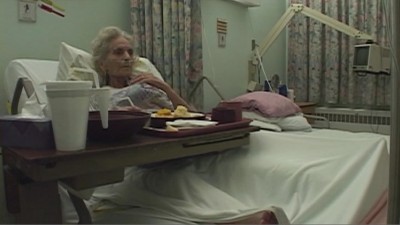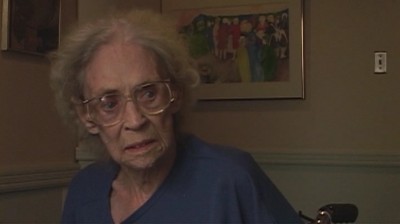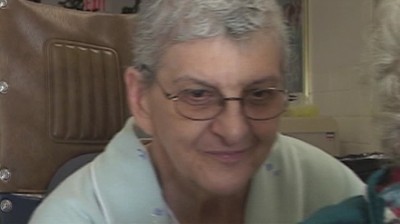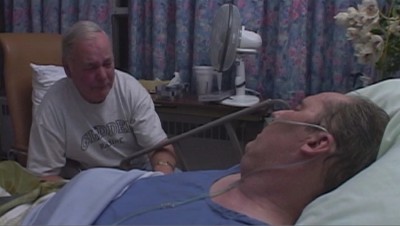| Reviews & Columns |
|
Reviews DVD TV on DVD Blu-ray 4K UHD International DVDs In Theaters Reviews by Studio Video Games Features Collector Series DVDs Easter Egg Database Interviews DVD Talk Radio Feature Articles Columns Anime Talk DVD Savant Horror DVDs The M.O.D. Squad Art House HD Talk Silent DVD
|
DVD Talk Forum |
|
|
| Resources |
|
DVD Price Search Customer Service #'s RCE Info Links |
|
Columns
|
|
|
Dying at Grace
King and film editor Nick Hector show great nerve in their decision to focus the first hour of Dying at Grace on just Carmela Nardone and Joyce Bone. At first blush, Carmela and Joyce appear to perfectly fit the stereotype of those who die in an institution. They are both frail, cancer-ridden, elderly widows. However, below the surface Carmela and Joyce could hardly be more different from one another. Carmela is a Roman-Catholic who immigrated to Canada from Italy as a young woman. She's a quiet, dignified woman who never complains, and appears to have made peace with her death. She's frequently surrounded by family and friends, but sends them away an hour before she dies, choosing to silently share her final moments with cameraman Peter Walker and soundman Jason Milligan who document her passing in close detail. Joyce Bone, on the other hand, is a stoic with a dry sense of humor. She has faced a great deal of misfortune in her life. She mourns the deaths of her parents, sibling, husband, and two of her three children. She doesn't believe in an afterlife, but fears death. Joyce struggles against each progressive decline in her health. At last, unable to find peace, she dies afraid and essentially alone.


The final hour and a half of Dying at Grace intercuts the end of life experiences of Eda, Rick, and Lloyd. Eda is the first of these three we see, and the last to die. A trim woman of about 60, she was a civil servant until she was diagnosed with terminal liver cancer. She's close to her deceased twin's husband, but otherwise is a very private person. Though she seems to strike up a few genuine friendships with some of the medical staff, she brooks no sympathy from anyone, and refuses to see friends or former colleagues. During the filming, Eda remarkably goes into remission, but on the eve of being discharged from the hospital she relapses falling into a rapid downward spiral.
Rick Pollard is the most flamboyant character of the lot. A heavily-tattooed former member of the violent biker gang Satan's Choice and a reformed drug addict, Rick remains a heavy drinker and smoker despite his terminal lung cancer. Rick refuses to acknowledge his imminent death. When the end comes, he struggles fiercely but then seems to find some contentment in the final moments, passing away peacefully.
The youngest of the participants, Lloyd Greenway, a Metropolitan Community Church minister, is suffering from inoperable brain cancer. Lloyd is tenderly cared for by his partner of thirty years Norman, and by a circle of close friends. When filming begins Lloyd is ready to pass on, but Norm wants him to fight. However, as Lloyd's condition deteriorates their roles reverse. When Lloyd is no longer lucid, and his body is wracked with pain, Norm at last urges Lloyd to let go. Finally, while surrounded by his partner and friends, Lloyd dies.



The staff at Toronto Grace are the most respectful, kind and compassionate professionals that anyone could ask for in such difficult circumstances. Salvation Army Major Phyllis Bobbitt, director of spiritual care services at Toronto Grace, non-judgmentally provides comfort to the five patients. She inquires of Joyce to determine whether she might find some solace in religion, but doesn't push when Joyce rejects the attempt. Similarly, neither she nor any of the staff appears to look down on Rick for his past, nor do they refuse him the comforts of beer and cigarettes in his last days.
Like Allan's 1968 documentary Warrendale, about a group home for emotionally-disturbed children, Dying at Grace is an example of Direct Cinema. Apart from a handful of intertitles at the beginning of the film, Dying at Grace documents the participants without narration, soundtrack or score, using simple, tight camerawork, and unadorned editing free of manufactured drama.
The DVD
Dying at Grace is offered directly from Allan King Films for $30, plus shipping.
Video:
The 16:9 image is enhanced for widescreen. While Dying at Grace has a passable image when viewed on a small screen, the DV image shows poor resolution, aliasing, and extreme edge enhancement on larger displays. This is a major disappointment after the comparatively excellent image quality on the DVD release of Warrendale filmed on 16mm film forty years ago.
Audio:
Dying at Grace features a 2.0 audio track. Though there appears to be no difference between the channels, dialogue is clear and crisp without excessive noise, distortion or dropout.
Optional French and German subtitles are provided.
Extras:
Dying at Grace includes two feature-length commentaries. The first, with Allan King, editor Nick Hector, and cameraman Peter Walker, is engaging and informative. They discuss in depth the planning and preparation for the film, the difficulties of shooting, and the basis of various choices in cinematography and editing, and their personal experiences with, and impressions of, the patients, family, and staff. Allan also explains in some depth what he calls "actuality dramas" which appears indistinguishable from Direct Cinema in all but name.
The second commentary includes Allan King and three staff members of the Salvation Army Toronto Grace Health Centre: Doctor Colette Hegarty, Major Phyllis Bobbitt, and Registered Nurse Allison Barbisan. This track suffers from many more silent periods than the filmmakers' commentary, and King largely remains silent deferring to the health care workers to share their observations. Nevertheless, the commentary is more or less informative providing further insight into the particulars of dying both for the five patients featured and more generally.
Final Thoughts:
Dying at Grace is an honest look at the experience of dying close up. It includes footage of ordinary deaths, no different from the sort that most of us will eventually personally experience, that are sometimes graphic and disturbing, but never sensational or exploitative. Like Warrendale, King's 1968 documentary about emotionally-disturbed children, Dying at Grace is demanding. While most of us find death an easy and entertaining subject when presented in the context of a Hollywood fiction, the reality of dying can be troubling to contemplate, and harder to watch.
Despite the rather poor image quality, if you have the nerve and inclination required to watch this transcendent exploration of natural death, Dying at Grace is recommended.
|
| Popular Reviews |
| Sponsored Links |
|
|
| Sponsored Links |
|
|
| Release List | Reviews | Shop | Newsletter | Forum | DVD Giveaways | Blu-Ray | Advertise |
|
Copyright 2024 DVDTalk.com All Rights Reserved. Legal Info, Privacy Policy, Terms of Use,
Manage Preferences,
Your Privacy Choices | |||||||













